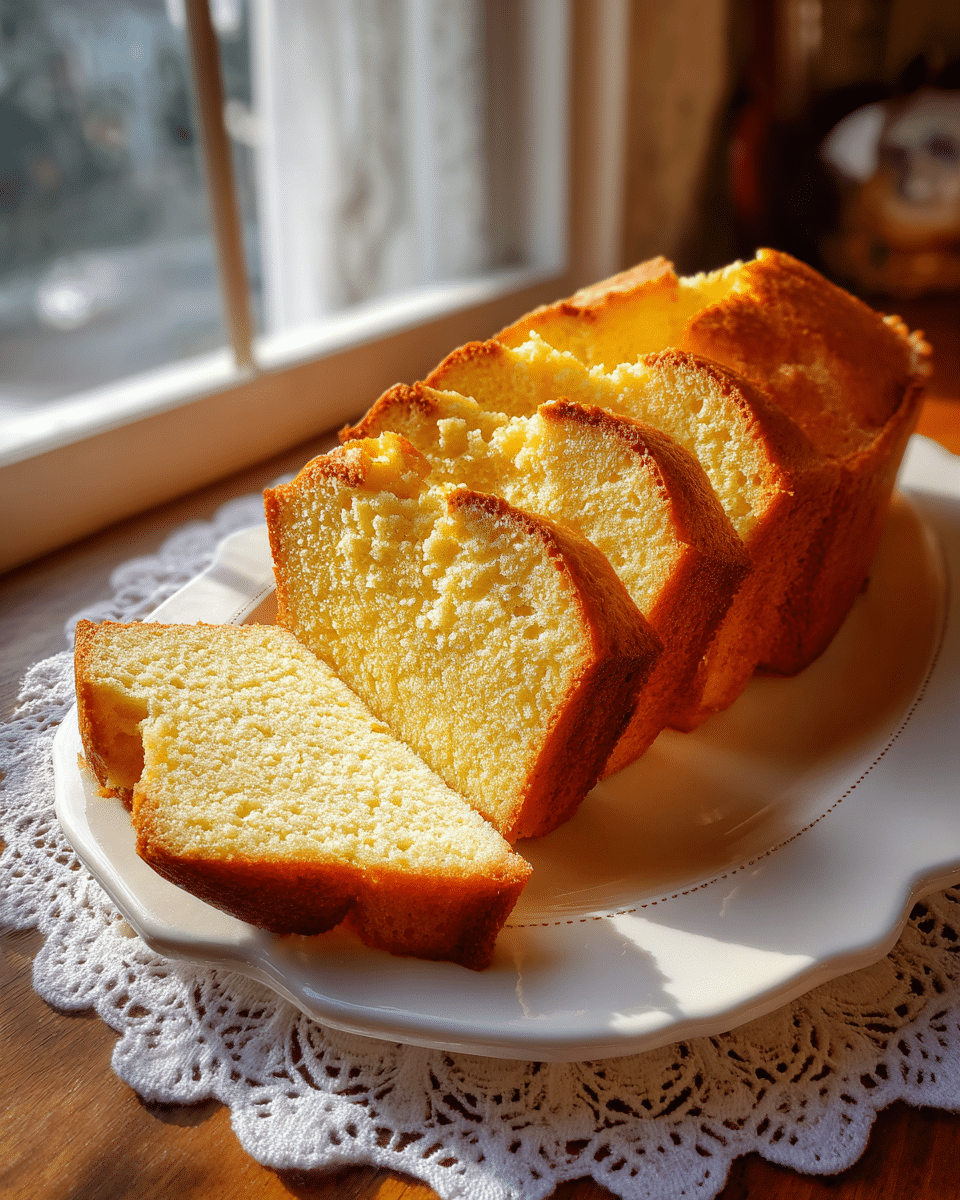This Classic Grandma’s Pound Cake brings back the comforting taste of old-fashioned baking. Rich, buttery, and delightfully dense, it’s a timeless recipe passed down through generations. Perfect with a cup of tea, a scoop of ice cream, or fresh berries, this cake captures the simple elegance of homemade desserts.
FULL RECIPE
Ingredients
- 1 cup (226g) unsalted butter, softened
- 2 cups (400g) granulated sugar
- 4 large eggs, room temperature
- 3 cups (375g) all-purpose flour
- 1 teaspoon baking powder
- 1/2 teaspoon salt
- 1 cup (240ml) whole milk, room temperature
- 2 teaspoons pure vanilla extract
Directions
- Preheat the oven to 325°F (165°C). Grease and flour a 10-inch (25cm) bundt or tube pan.
- In a large mixing bowl, cream together the softened butter and granulated sugar until light and fluffy, about 4–5 minutes.
- Add eggs one at a time, beating well after each addition to ensure a smooth batter.
- In a separate bowl, whisk together the all-purpose flour, baking powder, and salt.
- Gradually add the dry ingredients to the butter mixture, alternating with the milk. Begin and end with the flour mixture, mixing just until combined.
- Stir in the vanilla extract until evenly distributed.
- Pour the batter into the prepared pan, smoothing the top with a spatula.
- Bake for 60–70 minutes, or until a toothpick inserted into the center comes out clean.
- Allow the cake to cool in the pan for 10–15 minutes, then carefully turn out onto a wire rack to cool completely before slicing.
Nutrition Facts
- Calories: 380 kcal per slice (based on 12 servings)
- Total Fat: 17g
- Saturated Fat: 10g
- Cholesterol: 105mg
- Sodium: 180mg
- Total Carbohydrates: 52g
- Dietary Fiber: 1g
- Sugars: 30g
- Protein: 6g
History and Origin of Pound Cake
The pound cake is a classic dessert with roots tracing back to 18th-century Europe. Its name originally referred to the simple formula: one pound each of flour, butter, sugar, and eggs. This straightforward approach made it easy for bakers to remember and create a rich, dense cake without needing precise measurements. Over time, the recipe evolved with modern baking techniques, but the traditional dense texture and buttery flavor remain central to its charm, making it a beloved staple in many cultures.
Texture and Flavor Profile
Classic Grandma’s Pound Cake is known for its dense, moist texture and rich buttery taste. Unlike light and airy cakes, pound cake has a substantial crumb that holds up well to slicing and serving with toppings. The butter’s creaminess shines through, balanced by a subtle vanilla undertone, making every bite satisfyingly indulgent. This combination of richness and slight sweetness gives it its timeless appeal.
Health Considerations
While pound cake is a delicious treat, it is also calorie-dense due to the generous amounts of butter, sugar, and eggs. It provides a good source of energy and protein from the eggs but should be enjoyed in moderation as part of a balanced diet. Those mindful of saturated fat and sugar intake may want to enjoy smaller portions or look for healthier recipe adaptations.
Variations and Flavor Twists
This traditional recipe serves as an excellent base for creative variations. Adding citrus zest like lemon or orange can brighten the flavor, while incorporating spices such as cinnamon or nutmeg introduces warmth and complexity. Some bakers fold in fresh berries or chocolate chips to add bursts of flavor and texture. Additionally, substituting some of the flour with almond flour can impart a nutty taste and slightly lighter crumb.
Serving Suggestions
Classic Grandma’s Pound Cake is versatile and can be served in many ways. It pairs beautifully with fresh fruit, whipped cream, or a scoop of ice cream for an elegant dessert. For breakfast or brunch, a slice toasted lightly and spread with jam or honey offers a comforting start to the day. It also makes a great accompaniment to tea or coffee during afternoon gatherings.
Pairing Ideas
The rich buttery flavor of the pound cake pairs well with beverages such as black tea, coffee, or a mild dessert wine like Moscato. For a more decadent experience, serve it with a drizzle of caramel sauce or a berry compote. The cake’s subtle vanilla notes complement fresh berries and citrus fruits, creating a balanced and refreshing contrast.
Storage and Shelf Life
Proper storage is key to maintaining the cake’s moist texture. Pound cake can be kept at room temperature, wrapped tightly in plastic wrap or stored in an airtight container, for up to three days. For longer storage, it freezes well for up to three months. When ready to serve, thaw it at room temperature or warm briefly in the oven to restore its freshly baked softness.
Baking Tips for Success
Achieving the perfect pound cake requires attention to detail. Make sure all ingredients are at room temperature to help with proper mixing and a smooth batter. Cream the butter and sugar thoroughly to incorporate air and ensure a tender crumb. Avoid overmixing once the flour is added, as this can lead to a tough texture. Lastly, resist opening the oven door frequently to maintain steady baking temperature.
Nutritional Benefits and Drawbacks
While pound cake is often considered a treat rather than a health food, it does contain essential nutrients from its ingredients. Eggs provide protein and vitamins, while butter contributes fat-soluble vitamins like A and E. However, the high sugar and saturated fat content mean it should be enjoyed sparingly. For those looking to lighten the recipe, alternatives such as reduced sugar or butter substitutes can be experimented with.
Cultural Significance and Popularity
The pound cake has secured its place in many cultures worldwide as a symbol of comfort food and traditional baking. It is often associated with family gatherings, holidays, and celebrations, evoking nostalgia for simpler times. Its straightforward ingredients and preparation make it accessible to home bakers of all skill levels, contributing to its enduring popularity across generations.
Conclusion
Classic Grandma’s Pound Cake remains a timeless dessert cherished for its rich, buttery flavor and satisfying texture. Beyond its delicious taste, it offers versatility in serving and flavor variations, making it suitable for various occasions. While it’s best enjoyed in moderation, this cake carries a rich history and cultural significance that continues to delight families and bakers alike. Whether served plain or dressed up with toppings, it stands as a true testament to the enduring appeal of simple, heartfelt baking.






